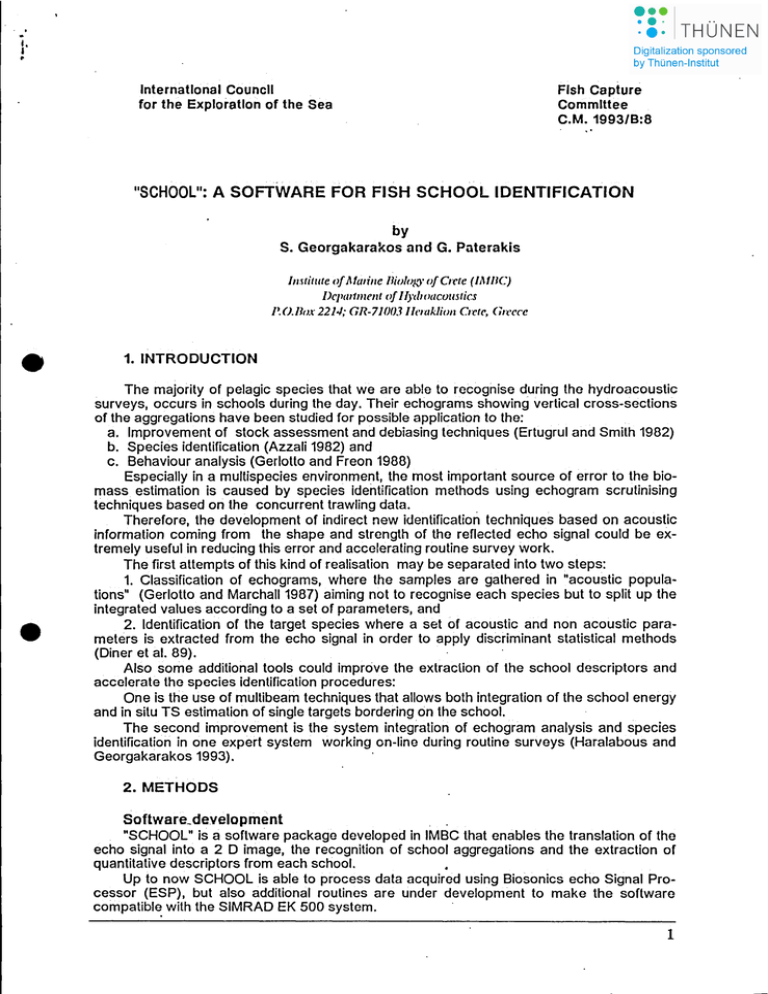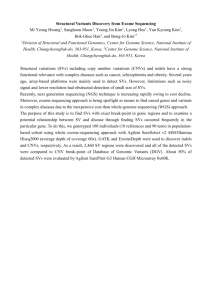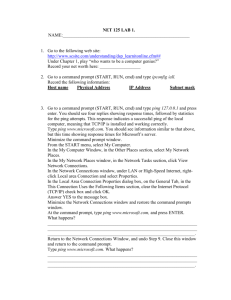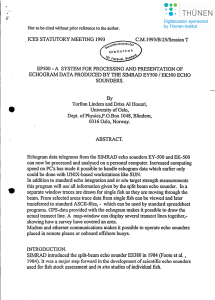. · I'
advertisement

. ·I' • International Councll for the Exploration of the Sea Fish Capture Commlttee C.M. 1993/B:8 "SCHOOl": A SOFTWARE FOR FISH SCHOOl IDENTIFICATION by S. Georgakarakos and G. Pate rakis Imtitwc o[ MaJillc JJiolo!:)' o[ O-etc (IM flC) J)Cl'ilI1mCIIl o[ IlycflOllCVllstics P. 0. flox 22].1; GR-7J()()3I1oakJioll ürtc, Gn'CCe • • 1. INTRODUCTION The majority of pelagic species that we are ab!e to recognise during the hydroacoustic surveys, occurs in schools during the day. Their echograms showing vertical cross-sections of the aggregations have been studied for possible application to the: a. Improvement of stock assessment and debiasing techniques (Ertugrul and Smith 1982) b. Species identification (Azzali 1982) and c. Behaviour analysis (Gerlotto and Freon 1988) Especially in a multispecies environment, the most important source of error to the biomass estimation is caused by species identification methods using echogram scrutinising techniques based on the concurrent trawling data. Therefore, the development of indirect new identification techniques based on acoustic information coming from the shape end strength of the reflected echo signal could be extremely useful in reducing this error and accelerating routine survey work. The first attempts of this kind of realisation may be separated into two steps: 1. Classification of echograms, where the sampies are gathered in "acoustic populations" (Gerlotto and Marchall 1987) aiming not to recognise each species but to split up the integrated values according to a set of parameters, and 2. Identification of the target species where a set of acoustic and non acoustic parameters is extracted from the echo signal in order to apply discriminant statistical methods (Diner et al. 89). . Also some additional tools could improve the extraclion of the school descriptors and accelerate the species identification procedures: One is the use of multibeam techniques that allows both integration of the school energy and in situ TS estimation of single targets bordering on the school. The second improvement is the system integration of echogram analysis and spedes identification in one expert system working en-Iine during routine surveys (Haralabous and Georgakarakos 1993). . 2. METHODS Software_development "SCHOOL" is a software package developed in IMBC that enables the translation of the echo signal into a 2 D image, the recognitien of schoel aggregations and the extraction of quantitative descripters from each scheol. • Up to now SCHOOLis able to process data acquired using Biesonics echo Signal Processor (ESP), but also additional routines are under development to make the software compatibl~ with the SIMRAD EK 500 system. 1 The software is IBM-PC cornpatible rind inCludes tha following routines: (echogram visualisation) -SCROLL -EDIT (posteriori replaying for chosen pings) . -FILTER (contiguity and threshold filters) -EXTRACT (extraction of school descriptors) -STATS (statistical pre-processing) The extracted parameters are analysed using commercial software (SYSTAT, STATGRAPHICS) or statistical routines developed in IMBC. Echogram_visualisation. The formation of the echogram is based on a set of elements (pixels) with aresolution equal to the pulse duration on tha vertical axis and to one ping interval on the horizontal axis. Each element is presented by tho sum of vortage square (svs), the ping number (i) and the depth interval in the water column U). The area (a) of each element is defined as the product of the horizontal distance (d) between two successive pings in meters and the vertical distance (h) between two successive integration layers: a = d. h In the ealculations of the geometrieal parameters of the school, the variables d and h aet as distance units for x and y axis respeetively. Integrated values (svs) from .tho TVG corrected and ealibrated signal are displayed on screen on a Jogarithmic basis. This logarithmic contrast enhaneement was useful in increasing the contrast between elements that have very low or very high energy value and in scaling the data within the range of the display device. Echogram_Replaying. After echogram visualisation both integration and TS data are matched to each other by using ping numbers and depth interval counters.. The software allows the user to change tha different settings (contiguity level, threshold energy, bottom recognition)concerning school identification and form a header file containirig information gained from the positioning equipment (GPS) and system clock (e.g. latitude, longitude, log, time, date) and the hydroacoustic parameters. • . Ih[esholding.and_contiguitY_filters. Three procedures have been developed to perform school recognition. The first procedure applied on the input data matrix is echo integration thresholding in order to cut-off very low biomass concentration. The second procedure is based on an algorithm that detects contiguous elements aJong the same ping or land contiguous elements from one ping to the next, in an i x j matrix of pixels. Elements that fulfil this continuity test are considered as belonging to the same aggregation. Ttie meaning of the third procedure is to distinguish between lowand high energy concentration of biomass. Such a procedure would be useful if it were necessary to remove plankton aggregations from the analysis of schools. The software is able to recognisa school aggregations from other echoes, define their boundaries and apply. geometrical eorrections to eliminata the beam patterneffects. The user is able to define in an interactive way tho input settings of the program (e.g. threshold of pixel energy , level of horizontal and vertical contiguity and school mean energy threshold). Dala.Acquisition Both real and simulated data have been used in order to test performance and sensitivity of the system. Data obtained from hydroacoustic surveys in Thermaikos Gulf in 1991 and 1992 have been analysed by using both SCHOOL software and spraadsheet tools for comparison and debugging purposes. Data collection at sea was peiiormed using Biosonics dual beam equipment operated at 120 kHz. The pulse duration was 0.5 to 1.0 msec and Integration was carried out over 1m water column per one transmission. Collected data were stored in analog (DAT) and digital (removable hard disks) form. 2 ~ ,'.. '. ", !. .,~\, l~ .~, . " • 3. RESULTS AND DISCUSSION Up to now 3420 schools have been encountered, digitised and analysed with this software. More than 90% of these schools belong to the three most common species in this area: - Sardine, Sardina pilchardus - Anchovy, Engraulis encrasicolus - Horse Mackerei, Trachurus mediterraneous • Selection_otschooLparamelers Special algorithms were developed in order to quantify the different school parameters. More than 30 parameters could be calculated by the SCHOOl software. They may be classified in three groups: morphologieal, energetic and spatio~temporal parameters. Morphological parameters contain information related to the size, shape and homogeneity of the aggregation. Energetic parameters are statistical quaritities which describe the dispersion pattern of the fish density inside the school and spatio-temporal parameters which locate the school in space and time (Table 1). . Since some of the extracted parameters are highly correlated, Prindpal Component Analysis (pca) has been used in order to reduce the number of the variables in the data set. Data were at first normalised and submitted to standard pca routines (Statgraphics, STSC ver. 5.22) Over 79% of data variability can be explained by the first three factors. The first component seems to be representative of the morphological descriptors (ElEM, PERl, RMAX), the second component ;s a combination of the bathymetric position (BMAX, ALT) and the·later describes the energy level of the school (SMEAN, SCV). Parameters extracted using the software package "SCHOOl" have also been submitted to standard Discriminant Function Analysis (DFA) and to a simulated artificial neural network in order to assodate the target species with a set cf school descriptors (Haralabous and Georgakarakos 1993). These results are indicative that by using the above descriptors on a neural network we are able to realise species identification. To obtain this approach both developments are designed to include Oll capabilities, which could facilitate the on line data flow of the school descriptors to the neural network program. • , " 4.REFERENCES Azzali, M. 1982. Regarding the possibility of relating echo signals features to c1asses of marine organisms: tests carried out in the north rind middle Adriatic Seri. Contrib. 23, Symp. Fish. Acoustics, Bergen, 21-24 June, 1982 . Ertugrul, M.G. and Smith, B.V. 1982. Multiple scattering effects in fish abundance estimation. Dep....Memo--Electron--Elect--Eng..JJniv~Birminghaml-(492) Gerlotto, F. and Freon, P. 1988. School structure observed in some c1upeid spedes. lCESLEASI.W.orILGroups, Ostend, Belgium, 19-22 Api-i11988. Gerlotto, F. and Marchall, E. 1987. The concept of Acoustic Populations: its use ror analysis the Results of Acoustic Cruises. Internat,-Symp...Esh....Acoust., June 22-26, 1987, SeattJe, Washington, USA. Haralabous, J. and Georgakarako~, S~ 1993. Flsh-School species identification using a neural network. lCES_19931B:LEish.Capture_Committee. Diner, N. et al. INES-MOVIES: a new acoustic data· acquisition and processing system. lCES-.CMJ9891B:...45.i1stLCapture_Committee. 3 • Thb~1 • 1 10 2 SPE SCHOOLBASE · · School ID Species ID I Species Composition Morphological • 3 ELEM Numbcr of elements (pixels)/school · 4 H 5 L I1eight of school LellgtIl of school m 6 PING1 7 PING2 W of the first ping of school 8 AREA 9 ELaN Area of school 10 11 12 13 14 15 16 17 18 FRA PERl RMIN RMAX RMEAN RVAR RCV CIRC RECT m - W of the last pillg of school Elongation of scllOol Fractal Dimension m2 4, 5 8, 11 · · Perimeter of school m Minimum Radius ofl'erimeter J1l MaximulIl Radius of Perimeter m Mean Radius ofPerimeter J1l Variance of Radius of perimeter Coclf.of variation of Radius of perimeter Circularity of school Rectangularity of school 14,15 8,11 4,5,8 · · Energetic • 19 20 21 22 23 24 25 26 27 28 SVST SVS SMIN SMAX TSS SCV CROWO PATCH IOD K Total SVS ofschool Mean per element SVS of school V2 3, 19 v2 Mininnun SVS of school V2 Maximum SVS of school V2 Mean TS of single fish · · Coclf. ofvariation ofSVS Mean Crowding of school Patchiness of school Index ofDispersion CIlIlIlping Cocfficient 3,19,23 3,19,23 3,19,23 3,19,23 3,19,23 · · - Spatio-temporal 29 30 31 32 33 34 35 36 37 38 39 40 41 DATE TIME AMIN AMAX AREL BOT BOn BOT2 OMIN OMAX OMEAN LON LAN · Date Time - Minimum Altitude J1l Maximwn Altitude Relative Allitude m 4,31,34 - Mean Bottom Depth J1l Bollom of first ping m Bottom of last ping m Minimum Depth of school Max Depth of 5chool . III m Mean DepUl of sehool J1l Longtitude • Latitllde • 4







